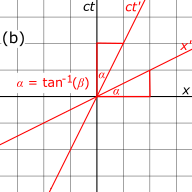Lorentz transformation and its inverse:
Define an event to have spacetime coordinates (t,x,y,z) in system S and (t′,x′,y′,z′) in a reference frame moving at a velocity v with respect to that frame, S′. Then the Lorentz transformation specifies that these coordinates are related in the following way:
where
is the Lorentz factor and c is the speed of light in vacuum, and the velocity v of S′, relative to S, is parallel to the x-axis. For simplicity, the y and z coordinates are unaffected; only the x and t coordinates are transformed. These Lorentz transformations form a one-parameter group of linear mappings, that parameter being called rapidity.
Solving the four transformation equations above for the unprimed coordinates yields the inverse Lorentz transformation:
Enforcing this inverse Lorentz transformation to coincide with the Lorentz transformation from the primed to the unprimed system, shows the unprimed frame as moving with the velocity v′ = −v, as measured in the primed frame.
There is nothing special about the x-axis. The transformation can apply to the y- or z-axis, or indeed in any direction parallel to the motion (which are warped by the γ factor) and perpendicular; see the article Lorentz transformation for details.
A quantity invariant under Lorentz transformations is known as a Lorentz scalar.
Writing the Lorentz transformation and its inverse in terms of coordinate differences, where one event has coordinates (x1, t1) and (x′1, t′1), another event has coordinates (x2, t2) and (x′2, t′2), and the differences are defined as
- Eq. 1:
- Eq. 2:
we get
- Eq. 3:
- Eq. 4:
If we take differentials instead of taking differences, we get
- Eq. 5:
- Eq. 6:















Comments
Post a Comment